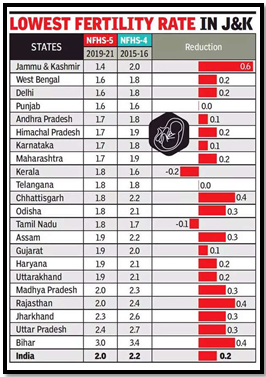“INDIA’S RAPID FERTILITY DECLINE AND ITS IMPLICATIONS”
Syllabus:
- GS-2- Population ,TFR, related issues and solution, Demographic dividend
Focus :
- The article discusses India’s rapid decline in Total Fertility Rate (TFR) and its impending demographic challenges. It emphasizes the need for proactive measures such as incentivizing childbirth, extending the productive work life of the elderly, promoting automation, and attracting skilled immigrants to sustain economic growth and leverage the current demographic dividend.
Source-IE
Introduction
- India is experiencing a rapid decline in its Total Fertility Rate (TFR), which is expected to drop to 1.29 by 2050.
- The decline is more rapid than previously anticipated, with significant demographic and economic implications.
- Similar trends have been observed in prosperous countries and those with specific population policies like China.
Current Fertility Trends
- As of 2021, India’s TFR is 1.91, below the replacement level of 2.1, indicating a future population decrease.
- Previous UN studies predicted a peak population of 1.7 billion by 2065, now expected to peak earlier and lower at around 1.6 billion.
- By 2100, India’s population is projected to decrease to around 1 billion, similar to its size a century earlier.
Global Comparison
- Countries like Japan, Singapore, and South Korea have TFRs below 1.5, indicating similar demographic challenges.
- China, despite not being as prosperous, has a TFR of 1.23, influenced by its one-child policy.
- Sharp declines in fertility rates are often irreversible, leading to fewer children and a shrinking workforce.
Demographic Dividend and Future Challenges
- India’s current demographic dividend, with a large working-age population, will eventually give way to an aging population.
- Better healthcare will increase longevity, raising the dependency ratio as the proportion of elderly dependents grows.
- A decreasing TFR will exacerbate the dependency ratio, increasing economic pressure on the working-age population.
Implications for India
- Adverse Dependency Ratio:
- The worsening dependency ratio will come sooner than anticipated, shortening the period of demographic dividend.
- Higher healthcare costs and pensions may lead to a financial crisis similar to those faced by developed countries.
- Lower Economic Growth:
- A stable or decreasing population will result in lower economic growth, as seen in many other countries.
- India, with a per capita income of $3,000, needs high growth for many decades to avoid economic stagnation.
Demographic Dividend:
Definition of Demographic Dividend
|
Capitalizing on the Demographic Dividend
- Immediate Actions:
- Urgent and comprehensive skilling programs to enhance the productivity of the working-age population.
- Learning from the experiences of other countries with low TFR and leveraging new technologies.
- Incentives for Childbirth:
- Creating an ecosystem that encourages childbirth to slow down the decline in fertility.
- Offering incentives and support to families to increase the birth rate.
- Extending Productive Work Life:
- Encouraging the elderly to remain productive through good health, reskilling, and suitable jobs.
- Reducing the dependency ratio by upskilling women for traditional and new livelihoods, especially in work-from-home (WFH) settings.
- Promoting Automation and Upskilling:
- Promoting automation and the use of robotics to minimize the need for more workers in the long run.
- Upskilling disadvantaged groups to increase their productivity and reduce economic disparities.
Immigration as a Solution
- Attracting Skilled Immigrants:
- Encouraging inward immigration, especially of skilled youngsters and students, to supplement the workforce.
- Offering long-term work permits and prioritizing skills needed in key areas.
- Learning from Other Countries:
- Countries like Singapore, Britain, and the US have significant foreign-born populations, which contribute to their economies.
- Even traditionally closed countries like Japan are now encouraging immigration.
- Building a Foreign-Born Population:
- India should aim to build a foreign-born population of 2-3% by 2050-2060 to sustain its workforce.
- This requires proactive policies and a welcoming environment for immigrants.
Policy and Research Initiatives
- Conducting research to determine the optimum population size and age composition for the future.
- Developing dynamic figures that consider health, fertility, economic factors, immigration, and technology.
- National Population Policy:Engaging in debate and dialogue to form a new national population policy that addresses future demographic challenges.
- Ensuring fast and continuous economic growth through proactive and well-planned measures.
Conclusion
- Without timely action, India risks facing social and economic stagnation due to demographic changes.
- Proactive steps are essential to maintain economic growth and achieve the ambition of becoming a developed country.
- Leveraging the current demographic dividend, promoting childbirth, extending the productive work life, encouraging immigration, and investing in automation and upskilling are critical strategies to address these challenges.
Source:The Hindu
Associated article
https://universalinstitutions.com/elderly-population-in-india/
Mains Practice Question :
GS-3
- Discuss the implications of India’s declining Total Fertility Rate (TFR) on its demographic structure and economic growth. What measures can be taken to mitigate the potential adverse effects of an aging population and ensure sustained economic development? Highlight the role of innovation, upskilling, and immigration in addressing these challenges.” (250 words)




